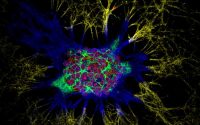Eating just one orange a day could prevent a common cause of blindness
Oranges really are the only fruit: Eating just ONE a day reduces people’s risk of blindness by 60% due to the citrus’ high antioxidant levels, study finds
- Oranges reduce people’s risk of developing age-related macular degeneration
- Due to ‘powerful antioxidants’ called flavonoids being anti-inflammatory
- Although flavonoids are in all fruit and vegetables, only oranges have benefits
- Researcher says even one orange a week has ‘significant benefits’
- Scientists plan to investigate genetic and environmental causes of eye diseases
Eating just one orange a day could prevent a common cause of blindness, new research suggests.
Snacking on the popular citrus fruit reduces people’s risk of developing age-related macular degeneration (AMD), which affects central vision, by 60 per cent, a study found.
Lead author Professor Bamini Gopinath, from the University of Sydney, said: ‘The data shows that flavonoids found in oranges appear to help protect against the disease.
‘Flavonoids are powerful antioxidants found in almost all fruits and vegetables, and they have important anti-inflammatory benefits for the immune system.’
Despite flavonoids also being found in other produce such as apples, for unclear reasons, only antioxidants in oranges protect against sight loss.

Eating just one orange a day could prevent a common cause of blindness (stock)
-

Gruesome moment woman, 30, has humongous lump of fat sliced…
Mother spends four hours EVERY DAY bathing her 9-month-old…
Why you should always put the lid down when flushing the…
Chocolate milk boosts exercise recovery MORE THAN sports…
Share this article
WHAT IS AGE-RELATED MACULAR DEGENERATION?
Age-related macular degeneration (AMD) is an eye condition that affects part of the retina.
It causes changes to central vision, which can make everyday tasks difficult, such as reading or watching television.
The ‘dry’ form of AMD is more common and causes gradual changes to a person’s vision.
‘Wet’ AMD develops very quickly due to the growth of blood vessels to correct damage to the retina.
These blood vessels cause swelling and bleeding that leads to scarring.
In both forms of the disease, only central vision is affected, not peripheral.
This can cause straight lines to look wavy or distorted.
There is no treatment for dry AMD. Wet AMD can be relieved with drugs that stop new blood vessels forming.
Source: Royal National Institute of Blindness
‘Even an orange once a week offers significant benefits’
The researchers analysed 2,037 adults with an average age of 49 for up to 15 years.
The participants’ diets were assessed via food questionnaires.
Results suggest that eating oranges protects against AMD compared to never snacking on the fruit.
Professor Gopinath added: ‘Even eating an orange once a week seems to offer significant benefits.’
The researchers plan to investigate what genetic and environmental factors cause eye diseases to occur.
The findings were published in The American Journal of Clinical Nutrition.
Eye patch improves vision in people battling a common condition
This comes after research released last April suggested a pioneering eye patch improves vision in people with severe age-related sight loss.
When implanted at the back of the eye of people suffering from dry macular degeneration, all experienced improved or stabilised vision, a study found.
One woman, aged 69, was even able to read 24 letters on an eye chart after having the device fitted, compared to just seven before, the research adds.
The device involves placing a wafer-thin patch coated with healthy embryonic retinal cells on the tissue near the optic nerve, which sends impulses to the brain where images are formed.
The researchers, from the University of Southern California, placed the patch, measuring 6x4mm, on the retinas of four people with advanced dry macular degeneration.
Each of the participants only had one eye tested, while the other served as a control.
One year on, the patch stabilised the disease in all of the participants’ treated eyes, while those that had not received the patch continued to deteriorate.
Two of the participants were better able to maintain their vision on a single object a year after the implant was fitted.
Source: Read Full Article


